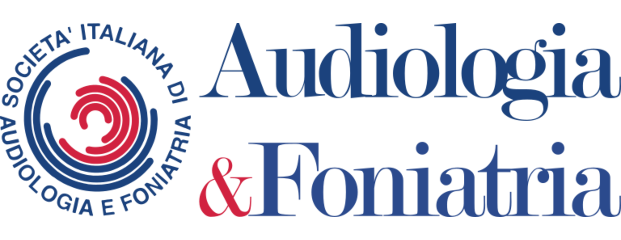For Authors
Manuscript Submission
IJAP publishes original research in the field of otorhinolaryngology, more specifically the intention is to cover topics related to auditory, balance, voice, speech and communication disorders.
IJAP is the official journal for the Italian Society of Audiology and Phoniatrics (SIAF).
The journal publishes original articles, editorials, letters to the Editor and systematic reviews.
Manuscripts must be submitted using the e-mail ijap.submission@gmail.com
All articles submitted must be original and have to present and follow a clear methodology.
They should not be under review or published somewhere else.
It is the Author’s responsibility to ensure that their manuscript is well-written and that the facts, grammar, use of punctuation and spelling are accurate. It is also the author’s responsibility to ensure that ideas and sources are cited appropriately and accurately.
Before submitting your manuscript, please ensure you carefully read and adhere to all the guidelines and instructions to authors provided below.
Manuscripts not conforming to these guidelines may be returned.
Form and Style
Articles should be compiled in the following order: title page; author(s); abstract; keywords; main text (number of tables and figures cited in the article); acknowledgement; references; appendices.
Language must be in English. Writing should be concise and correct.
Length should not exceed 10.000 words.
The title page should include: 1) a concise and informative title; 2) complete contact information for all authors (Name and Surname, affiliation, email address). 3) abstract. It should be a summary of the article and not an introduction, it should be easy to read and where appropriate it should be structured. Maximal length of the abstract is 250 words; 4) keywords.
Tables, figures and illustrations: the purpose of tables and figures is to present data to the reader in a clear and unambiguous manner.
Authors should not describe the data in the text in such detail that illustration or text is redundant. Tables/Figures/Illustrations should be submitted in Microsoft Word, RTF or Excel Format typed on separate pages. They should be numbered consecutively and cited in the article.
Reference list: a reference list contains only references that are cited in the text. Its accuracy and completeness are the responsibility of the author(s).
Authors are requested to format their research articles by using this template, available for download from www.padovauniversitypress.it/norme-editoriali-e-template.
References
Strictly use the following style (ensure that all relevant information is included)
Works should be cited in the text by the name/date system: that is, give the author’s surname, year of publication and, where relevant, the page reference immediately after the material derived from the source, e.g. (Coen 2013, 64).
When referring to text spanning more than one page: (Mendez 2002, 81-83).
When a source has two authors, place both authors’ surnames in the order in which they appear on the source, with the word and separating them.
If there are three or more authors, only use the first listed author’s name in the in-text citation, followed by “et al.” and the publishing year in the text, but give all the authors’ names in the reference list/bibliography.
Where there are two or more works by the same author in the same year, they should be distinguished by adding letters: 1997a, 1997b, etc.
Please include page reference numbers for all direct citations.
If footnotes are used, please set the footnote number before the full stop (if the footnote is at the end of the sentence).
In the bibliography/list of references please follow this style (punctuation, upper/lower case, italics/roman) exactly:
for books: Surname, Initial. Initial. (Date of publication) Title, Place of publication: Press. E.g. Hill, C. (2016) Foreign Policy in the Twenty-first Century, London: Palgrave.
for articles in journals: Surname, Initial. Initial. (Date of publication) ‘Title of paper’, Title of Journal, volume number (issue number), x-y.
for chapters in books: Surname, Initial. Initial. (Date of publication) ‘Title of paper’, in Surname, Initial. Initial. (of all authors) (ed./eds.), Title of the book, Place of publication: Press, x-y.
for books or documents that are published online only please provide the URL and the date of access.
for more authors: Surname, Initial. Initial., Surname, Initial. Initial., ..., and Surname, Initial. Initial. (Date of publication) ...
for online-only resources (non-formatted articles, blog posts, newspapers news, policy documents, videos, video interviews etc.) it is necessary to refer to the URL and the date of access, following this syle: Surname, Initial. Initial. or Name of the Organisation/Institution/Association (Date of publication) ‘Title of the resource’, retrieved from: complete URL (accessed: gg/mm/yyyy).
Conflict of interest
Are there other relationships or activities that readers could perceive to have influenced, or that give the appearance of potentially influencing, what you wrote in the submitted work? A declaration must be included (or… No other relationships/conditions/circumstances that present potential conflict of interest)
This structure is recommended, but it is not obligatory, for review articles and for case reports. Please note that, if the above structured discussion scheme is not followed in research papers, the manuscript will be returned without undergoing peer review.
Ethics permission
The editors and the publisher support the principles of the Declaration of Helsinki, and expect the authors of papers submitted to the journal to have obtained ethical consent and followed all legal and regulatory requirements for human experimentation with drugs, including informed consent, applicable in their institution and country. The Editor of IJAP reserves the right to ask for a copy of the Ethics permission of any manuscript submitted.

 © 2025 Padova University Press - Università degli Studi di Padova
© 2025 Padova University Press - Università degli Studi di Padova